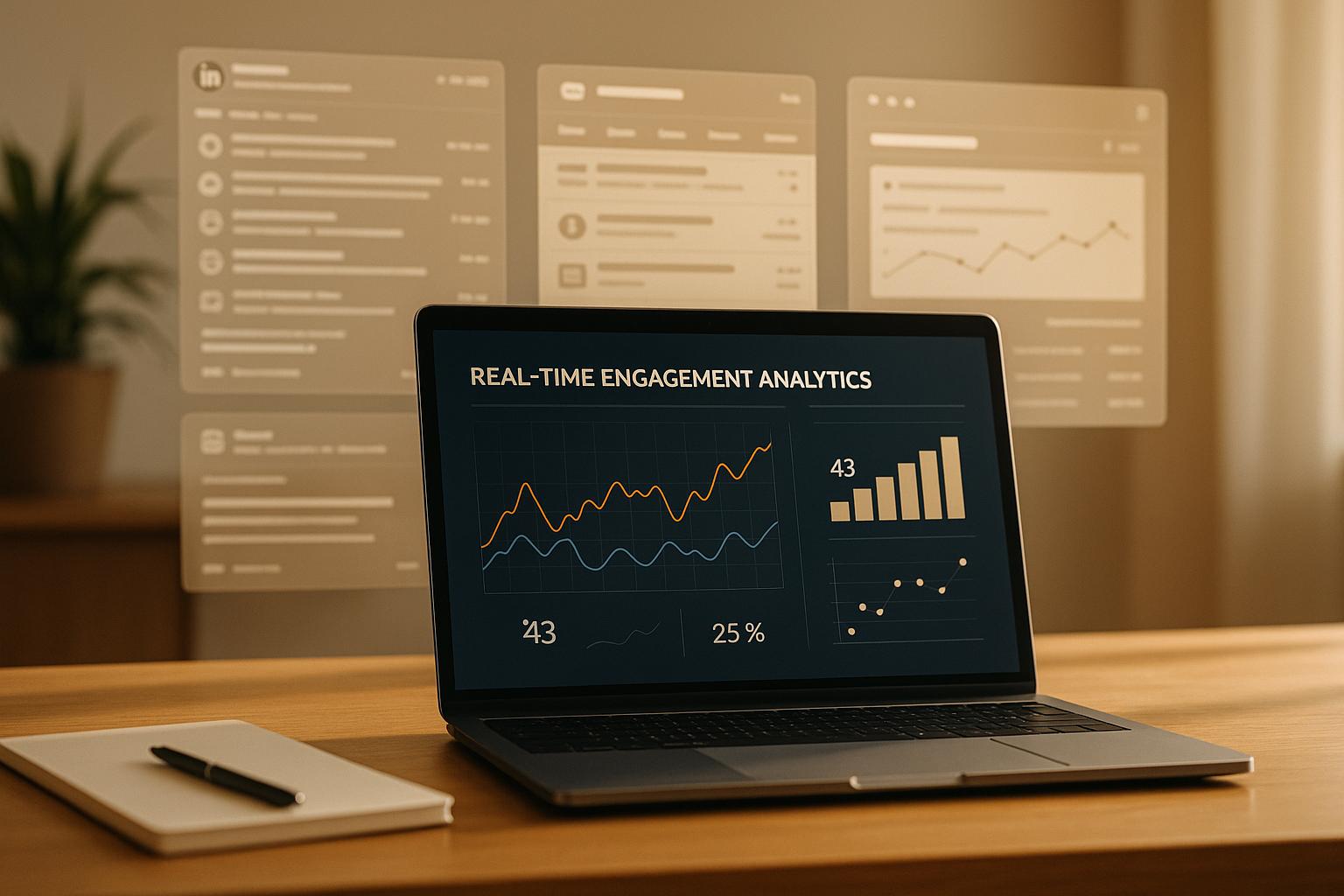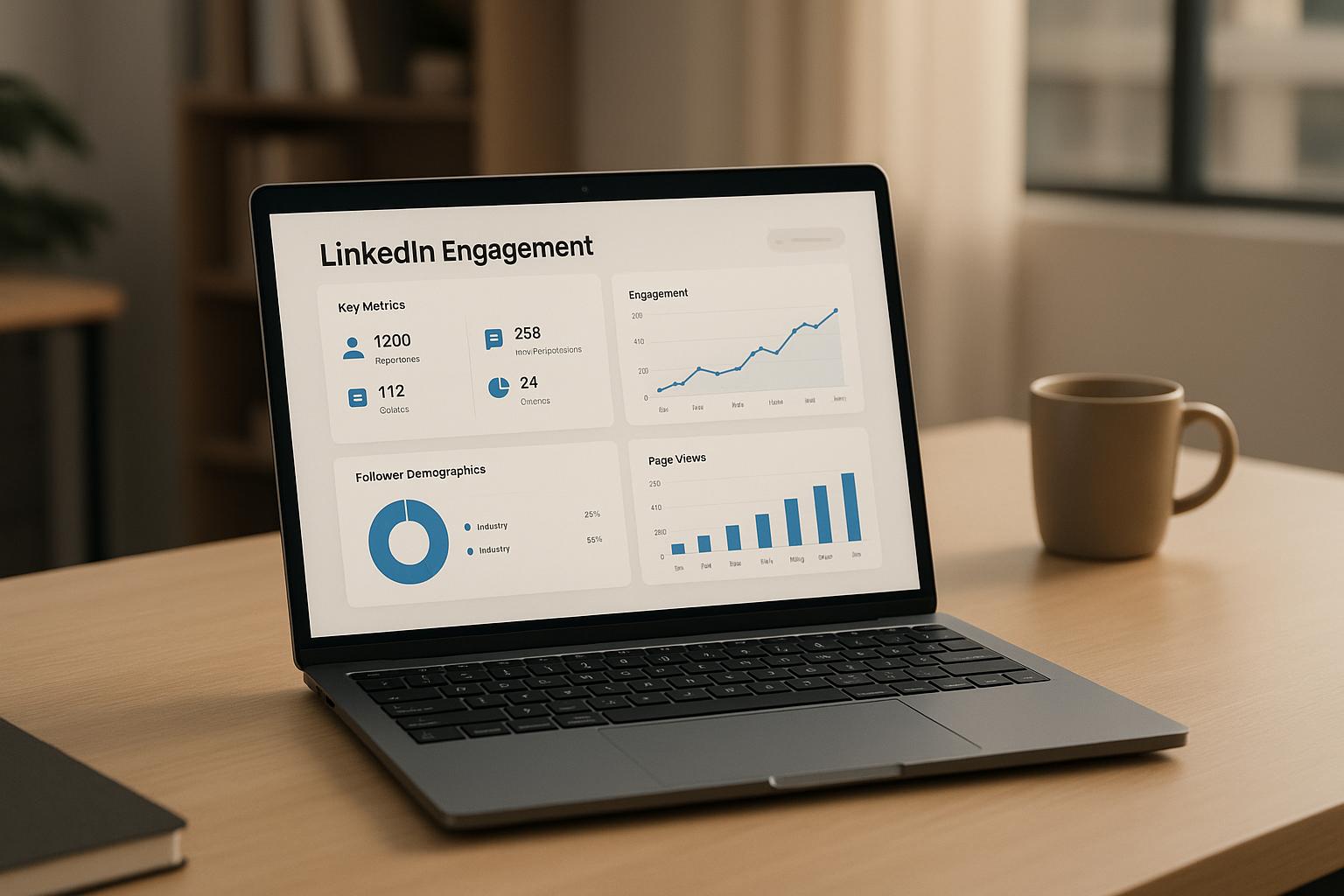
.avif)
Julien Gadea
Julien Gadea specializes in AI prospecting solutions for business growth. Empowering businesses to connect with their audience with SalesMind AI tools that automate your sales funnel, starting from lead generation.
LinkedIn analytics tools can help B2B sales teams in the U.S. make smarter decisions by providing actionable data on prospect behavior, content performance, and engagement trends. These tools go beyond basic metrics, offering features like lead scoring, real-time tracking, and CRM integrations, which are essential for optimizing sales strategies and closing deals faster.
Here’s a quick rundown of the top tools:
- SalesMind AI: Focuses on automated LinkedIn outreach with AI-driven lead scoring and real-time tracking.
- SocialInsider: Specializes in content performance tracking and competitor analysis for refining messaging strategies.
- Planable Analytics: Combines content planning with performance tracking to streamline LinkedIn-focused workflows.
- Keyhole: Excels in monitoring trends, hashtags, and industry conversations to spot opportunities.
- Sprout Social: Offers advanced LinkedIn analytics and multi-account management for large organizations.
Quick Comparison:
| Tool | Key Features | Ideal For | Pricing Tiers |
|---|---|---|---|
| SalesMind AI | AI-driven outreach, lead scoring | B2B sales teams | Basic, Pro, Enterprise |
| SocialInsider | Content tracking, competitive analysis | Content-focused teams | Multiple plans |
| Planable Analytics | Content planning, audience insights | LinkedIn content managers | Workspace-based |
| Keyhole | Trend monitoring, hashtag tracking | Trend-focused teams | Individual to agency |
| Sprout Social | Advanced analytics, multi-account | Large organizations | Tiered pricing |
Choose a tool based on your sales goals, team size, and budget. Tools like SalesMind AI are ideal for automated lead generation, while Sprout Social suits larger teams managing multiple accounts. Use these tools to refine your LinkedIn strategies, identify high-value prospects, and drive measurable results.
LinkedIn Company Page Competitor Analytics 2022
How to Choose the Right LinkedIn Analytics Tool
Picking the right LinkedIn analytics tool can be a game-changer for B2B sales. With so many options out there, it’s easy to get bogged down by flashy features that don’t directly contribute to revenue. The trick is to zero in on tools that align with your sales goals and fit smoothly into your workflow.
Your tool should provide answers to the big questions: Which prospects are showing interest? What messaging connects best with your audience? How does your team’s performance compare to industry standards? Without these insights, it’s tough to build a winning sales strategy.
Budget is another key factor, especially for U.S.-based businesses. Enterprise-level tools often come with high per-user fees and added costs for advanced features like AI-driven lead scoring. Don’t forget to account for training, setup, and integration expenses when calculating your total investment.
Real-Time Performance Tracking
In today’s fast-moving B2B world, having real-time insights into your LinkedIn sales activity is a must. Your analytics tool should give you up-to-the-minute data on connection requests, message responses, and content engagement. This allows you to tweak your strategy immediately instead of waiting for outdated reports.
Go beyond surface-level metrics. For example, tools that analyze response times can help you identify the best times to reach out, while tracking message open and click-through rates shows what grabs your audience’s attention. Even profile view tracking can be a goldmine for spotting prospects actively researching your business.
Custom alerts are another powerful feature, especially for sales managers juggling multiple team members. Imagine getting notified the moment a high-value prospect interacts with your content - this kind of real-time intelligence gives your team the edge to act fast and close deals.
Customizable dashboards are also a big plus. Sales reps can focus on metrics like individual engagement and pipeline progress, while managers get a high-level view of team performance and quotas without sifting through unnecessary data. And when it comes to boosting productivity, strong lead qualification features are just as important.
Lead Generation and Qualification Features
Building on real-time tracking, effective lead qualification can set top-performing sales teams apart. A good LinkedIn analytics tool should go beyond basic demographic filters and use behavioral data - like content engagement and activity patterns - to score and prioritize leads.
AI-powered lead scoring is especially helpful for managing large prospect lists. Advanced tools can rank leads based on factors like company growth, job changes, or engagement trends, helping your team focus on the prospects most likely to convert.
Adding intent data takes things a step further. For instance, if a prospect’s company is actively researching solutions like yours, that’s a signal to move them up in your pipeline. Some tools even automate list building based on your ideal customer profile, continuously identifying new prospects that match your most successful clients. This keeps your pipeline full without requiring constant manual effort.
CRM and Sales Tool Integration
For a smooth sales process, your LinkedIn analytics tool needs to work seamlessly with your existing systems. It should sync prospect interactions, engagement history, and contact details directly with your CRM, cutting down on manual data entry and reducing errors.
Look for tools that integrate natively with popular CRMs like Salesforce, HubSpot, or Microsoft Dynamics. The best options offer bi-directional syncing, so updates in one system automatically reflect in the other, keeping your data consistent and up to date.
Automation is another major time-saver. For example, when a prospect hits a certain engagement threshold, the tool could automatically assign a follow-up task to a sales rep or trigger a personalized email sequence. These automated workflows ensure no opportunity slips through the cracks, even during busy times.
Finally, consider how well the tool fits into your broader sales and marketing ecosystem. Tools that can trigger actions across platforms based on prospect behavior help create a connected, intelligent sales operation. API access and webhook support can also be useful for businesses with unique integration needs, giving you the flexibility to adapt as your operations grow.
Top LinkedIn Analytics Tools for B2B Sales
These tools offer tailored features to help B2B sales teams maximize their LinkedIn efforts.
SalesMind AI

SalesMind AI is a LinkedIn outreach automation platform designed specifically for B2B sales. It combines AI-driven messaging with lead scoring to help teams connect with prospects efficiently and at scale.
The platform features a unified inbox that consolidates LinkedIn conversations, making it easier to manage outreach. Its AI-powered lead scoring ranks prospects based on their engagement, continuously refining recommendations to ensure sales teams focus on the most promising leads. Automated follow-up sequences allow sales reps to create personalized drip campaigns that adjust to each prospect's responses, keeping interactions relevant and timely without losing the human element.
With real-time tracking, users get instant updates on prospect interactions, while seamless CRM integration ensures all data flows smoothly into existing sales processes. SalesMind AI offers three pricing tiers - Basic, Professional, and Enterprise - catering to small teams, growing businesses, and large-scale enterprises.
SocialInsider
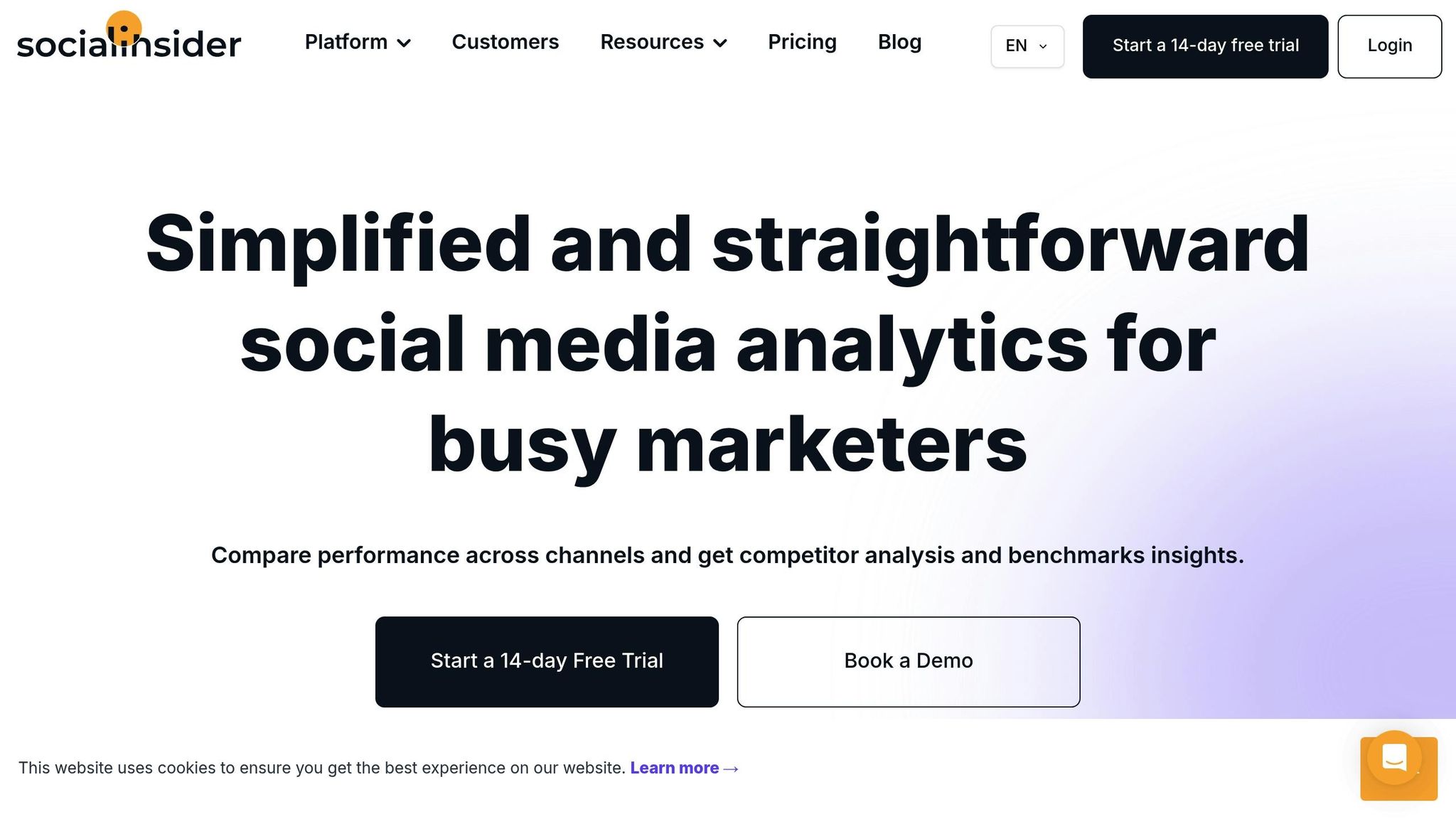
SocialInsider provides an all-in-one platform for tracking content performance, audience engagement, and competitor activity. Its customizable dashboards make it easy to monitor key metrics, such as post engagement and follower growth, helping teams identify which content resonates most with their audience.
The tool includes robust campaign tracking features, allowing users to measure reach, impressions, click-through rates, and conversions. This data-driven approach supports the refinement of messaging strategies and ensures alignment with real-time trends. Additionally, competitive benchmarking helps businesses assess their performance against industry peers.
SocialInsider offers a range of pricing plans to suit different needs, from basic analytics to advanced features like competitor analysis and custom reporting.
Planable Analytics
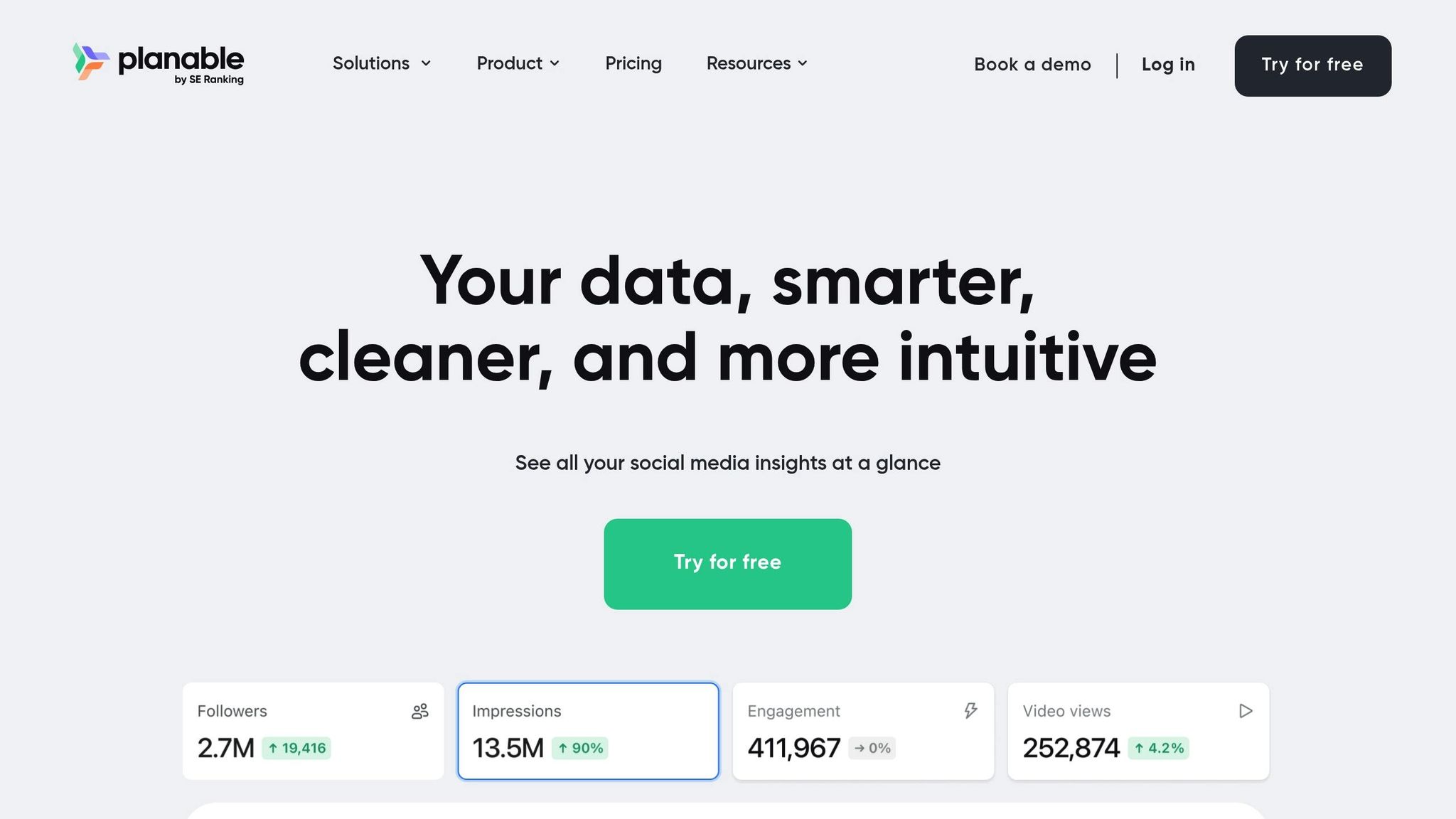
Planable Analytics is a versatile tool that combines content planning with performance tracking, making it a great choice for sales teams focused on LinkedIn content. Its collaborative content management features simplify workflows, streamlining the content creation process.
The platform emphasizes metrics that matter to sales teams, such as engagement rates, lead generation performance, and audience growth. It also provides detailed audience insights, including follower demographics and engagement patterns, helping teams craft more targeted and impactful messages.
Planable Analytics uses a flexible, workspace-based subscription model, accommodating both small teams and larger organizations that require advanced analytics and custom integrations.
Keyhole
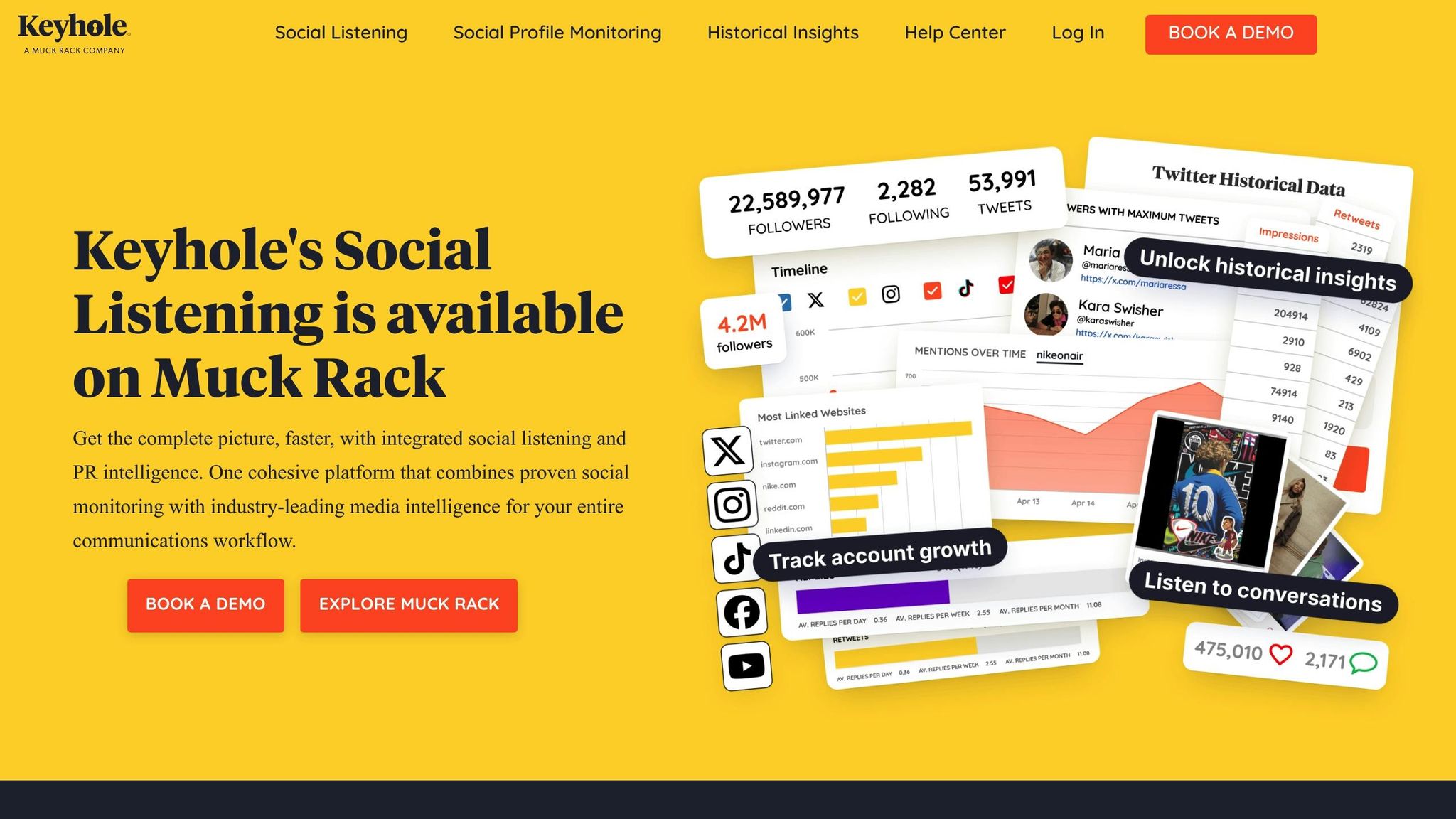
Keyhole excels at monitoring trends and tracking hashtags, helping teams stay ahead of industry conversations and uncover emerging opportunities. By analyzing LinkedIn discussions in real time, it identifies relevant topics and potential leads as they arise.
The platform's competitor benchmarking feature highlights areas where teams can improve by comparing their LinkedIn performance to industry leaders. Additionally, its brand mention monitoring alerts users whenever their company or key industry terms are mentioned in LinkedIn discussions, enabling timely engagement with interested prospects.
Keyhole’s pricing caters to a range of users, from individuals and small teams to larger agencies, offering everything from basic tracking to advanced analytics with collaboration features.
Sprout Social
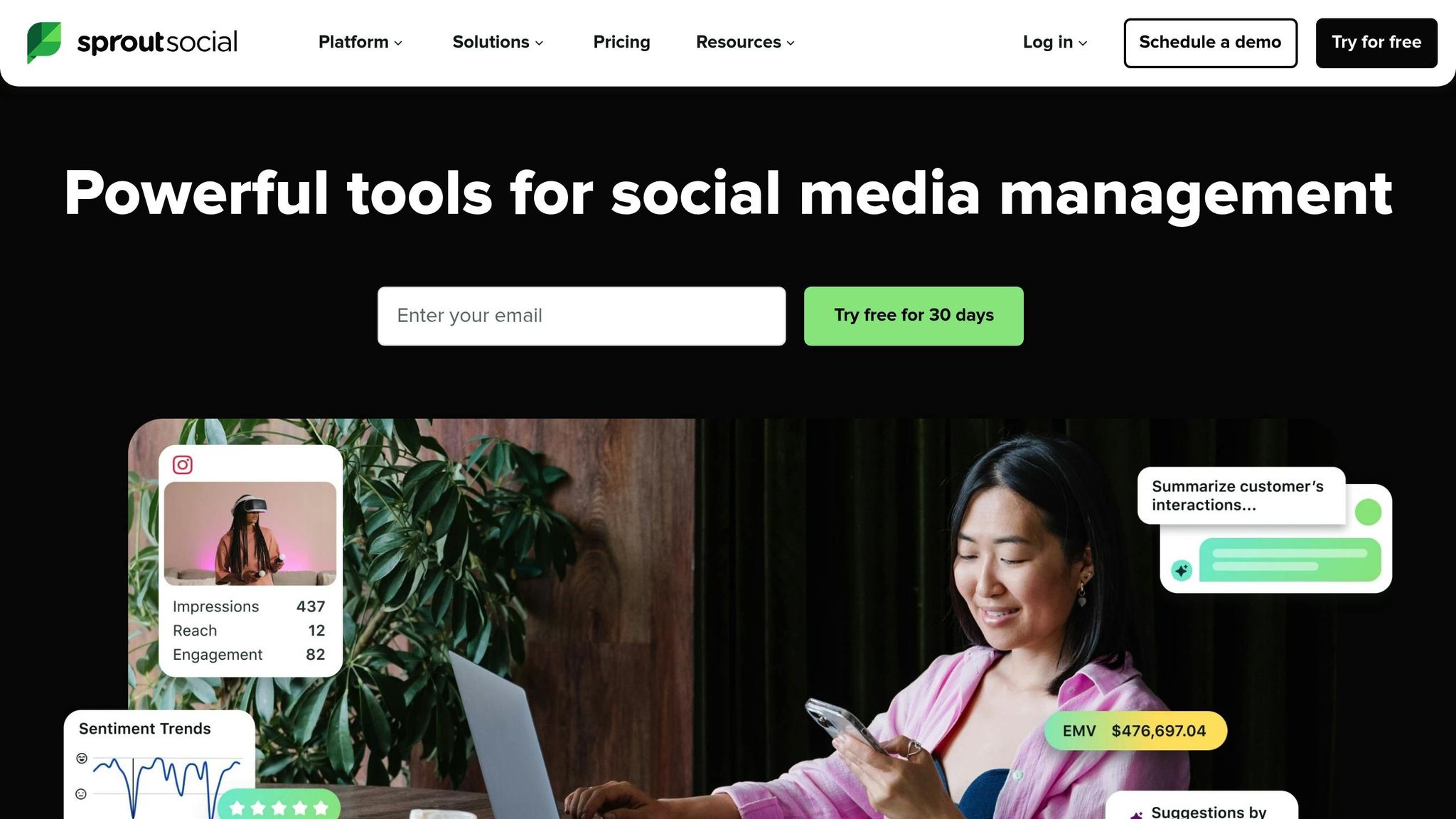
Sprout Social delivers enterprise-level LinkedIn analytics through its comprehensive social media management platform. Its advanced audience insights provide detailed demographic and behavioral data, helping sales teams identify and target ideal prospects more effectively.
The platform supports multi-account management, making it an excellent choice for larger organizations overseeing multiple LinkedIn pages or sales accounts. It centralizes activity while maintaining detailed oversight of individual performance.
Premium features include custom report building, competitive analysis, and ROI tracking that directly links LinkedIn activities to sales outcomes. Sprout Social also integrates with popular CRM systems, ensuring a smooth data flow across sales workflows. Its tiered pricing options cater to businesses of all sizes, offering tools for essential analytics as well as advanced insights and reporting capabilities.
sbb-itb-817c6a5
LinkedIn Analytics Tools Comparison
Side-by-Side Tool Comparison
Based on the criteria discussed earlier, here's a side-by-side comparison of LinkedIn analytics tools. This breakdown can help you choose a tool that aligns with your needs, budget, and team size.
| Tool | Core Features | Real-Time Tracking | Lead Generation | Reporting Options | Pricing (USD) | Ideal Use Case |
|---|---|---|---|---|---|---|
| SalesMind AI | LinkedIn outreach automation, automated messaging, unified inbox, lead scoring | ✅ Real-time lead tracking | ✅ Automated lead qualification | Custom dashboards, CRM integration reports | Basic, Professional, Enterprise tiers | B2B sales teams focusing on automated outreach and lead qualification |
| SocialInsider | Content performance tracking, competitor analysis, audience engagement | ✅ Campaign metrics monitoring | ✅ Conversion tracking and lead measurement | Customizable dashboards, competitive benchmarking | Multiple pricing plans available | Teams prioritizing content strategy and competitive intelligence |
| Planable Analytics | Content planning, performance tracking, collaborative workflows | ✅ Engagement and audience growth tracking | ✅ Lead generation performance metrics | Detailed audience insights, demographic analysis | Workspace-based subscription model | Sales teams combining content creation with analytics |
| Keyhole | Hashtag monitoring, trend analysis, brand mention tracking | ✅ Real-time industry conversation monitoring | ✅ Opportunity identification through trend analysis | Competitor benchmarking, mention alerts | Individual to agency pricing tiers | Teams focused on trend monitoring and brand awareness |
| Sprout Social | Enterprise-level analytics, multi-account management, audience insights | ✅ Comprehensive social media monitoring | ✅ ROI tracking linked to sales outcomes | Custom report building, advanced analytics | Tiered pricing for all business sizes | Large organizations managing multiple LinkedIn accounts |
Key Differences to Consider
Each tool has distinct advantages tailored to specific needs:
- SalesMind AI: Designed for B2B sales teams, this tool stands out with its AI-powered automation and precise lead qualification, making it ideal for scalable, personalized outreach.
- SocialInsider: Offers exceptional competitive analysis and benchmarking, helping teams identify content gaps and better understand their market position.
- Planable Analytics: Combines content planning and analytics, streamlining workflows for teams managing LinkedIn content from creation to performance tracking.
- Keyhole: Specializes in monitoring trends and hashtags, making it a great choice for teams that need to stay ahead of industry conversations and spot opportunities quickly.
- Sprout Social: Provides enterprise-grade features, including multi-account management and advanced analytics, making it a strong option for large organizations with complex LinkedIn operations.
Choosing the Right Tool
Your choice should depend on your primary goals:
- If automated lead generation is your focus, SalesMind AI offers a targeted, scalable solution.
- For content-driven strategies, both SocialInsider and Planable Analytics deliver valuable performance insights.
- Teams aiming to stay current with industry trends will benefit from Keyhole's real-time monitoring.
- Large organizations managing multiple accounts may find Sprout Social's enterprise features indispensable.
Pricing varies widely among these tools. Some use flexible workspace-based models, while others rely on traditional tiered plans. Most platforms are designed to scale, ensuring they can grow alongside your team and budget.
Conclusion
LinkedIn analytics tools have become a game-changer for U.S. B2B sales teams. These platforms provide data-backed insights that replace guesswork with strategy. By analyzing content performance, audience demographics, and campaign success, sales professionals can make smarter decisions that directly impact revenue. As discussed earlier, these tools help teams identify and target the right prospects with precision.
Analytics also play a crucial role in justifying budgets by connecting LinkedIn activities to measurable revenue growth [1]. In today’s competitive market, tracking metrics like profitability and revenue ensures that LinkedIn efforts are directly tied to tangible business outcomes.
Real-time tracking adds another layer of value, enabling sales teams to tweak their outreach strategies on the fly. Whether it’s monitoring engagement patterns, understanding follower behavior, or assessing campaign performance, having access to up-to-date data allows for immediate action to seize opportunities before they’re lost.
The combination of AI-powered automation and analytics takes this a step further. These tools not only simplify prospecting but also refine sales strategies over time. This approach ensures continuous improvement while scaling B2B sales efforts efficiently.
Key Takeaways
LinkedIn analytics and AI-driven tools are reshaping how top U.S. B2B sales teams approach LinkedIn strategies. Tools like SalesMind AI showcase how automation paired with analytics enables scalable and personalized outreach, offering features like advanced lead scoring and real-time tracking.
When choosing a LinkedIn analytics platform, look for one that integrates seamlessly with your CRM and aligns with your existing sales workflows. The most effective tools don’t just deliver raw data - they provide actionable insights that guide your team from the first LinkedIn interaction to final conversion, driving meaningful revenue growth.
FAQs
How do LinkedIn analytics tools help B2B sales teams enhance their strategies and close deals more efficiently?
LinkedIn analytics tools give B2B sales teams a powerful way to understand their audience, track content performance, and measure campaign success. These insights make it easier to spot promising leads, figure out what content connects with the audience, and fine-tune outreach efforts for stronger engagement.
With this data in hand, sales teams can craft more tailored messages, adjust their strategies, and concentrate on prospects with the highest chance of converting. The result? A shorter sales cycle, improved efficiency, and quicker deal closures.
What should B2B sales teams look for in a LinkedIn analytics tool?
When choosing a LinkedIn analytics tool for your B2B sales team, it's important to pick one that matches your specific objectives and can grow alongside your business. Look for features like data visualization, predictive analytics, and audience segmentation. These tools can help you pinpoint insights that directly impact your sales strategies.
Make sure the tool works smoothly with your current CRM systems and offers in-depth tracking of key metrics such as follower demographics, engagement rates, and post performance. These details are invaluable for fine-tuning your outreach efforts and boosting your sales results.
How do real-time tracking and AI-powered lead scoring improve LinkedIn analytics tools for B2B sales teams?
Real-time tracking enhances LinkedIn analytics tools by providing immediate insights into sales activities. This means teams can quickly identify successful strategies and make adjustments on the fly, keeping their efforts efficient and effective.
On top of that, AI-powered lead scoring adds another layer of precision. By automatically ranking leads based on their likelihood to convert, it helps sales teams zero in on the most promising prospects. This not only saves time but also ensures resources are directed where they’ll have the most impact. Combined, these tools simplify decision-making, sharpen targeting, and boost sales performance.




